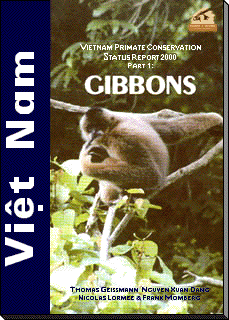Geissmann, T.;
Nguyen Xuan Dang;
Lormée, N. & Momberg, F. (2000). Vietnam primate conservation
status
review 2000 - Part 1: Gibbons. Fauna & Flora International,
Indochina Programme,
Hanoi. 130 pp. ISBN: 1-903703-03-4. English edition.
 |
Vietnam Primate Conservation
Status Review 2000 - Part 1: Gibbons
Thomas Geissmann; Nguyen Xuan
Dang; Nicolas Lormée and Frank Momberg
ISBN 1-903703-03-4, 2000,
Paperback, 130 pages, 9 figures, 7 colour plates. Fauna & Flora
International, Indochina Programme, Hanoi, Vietnam.
Available from:
You may also download the
whole book as a PDF file.
The file is big (14 MB).
Download begins if you click here.
|

Summary
by Thomas Geissmann
Gibbon Research Lab., Hannover
Although several faunistic surveys
have been carried
out in Vietnam in recent years, survey results have rarely been
published. Research
results, too, are often preliminary reports published in little-known
local journals.
A critical reassessment of the gibbon populations, their size and their
phylogenetic
affinities is urgently required.
The Vietnam Primate Conservation
Status Review began
implementation in July 1999 with the objective of collating a
comprehensive data
set for leaf monkeys and gibbons. The results on gibbons have now been
published
(Geissmann et al., 2000). This is not only the first nation-wide status
review of
Vietnamese gibbons, but also the first book publication on gibbons
since several
years. An edition in Vietnamese language has also been published.
Recent research results suggest that
the diversity
of Indochinese gibbons is larger than previously assumed. All
Vietnamese gibbons
are members of the genus Nomascus (crested gibbons). The
affinities of populations
in central Vietnam and southern Laos appear to be particularly complex.
Based on earlier reports, museum
specimens or forest
quality, we were able to identify 87 potential gibbon areas in Vietnam.
During the
last 5 years, however, the occurrence of gibbons was only confirmed for
21 of these
areas. In 17 additional areas, the occurrence of gibbons is probable,
albeit not
reliably documented. In 49 areas (56.3%), gibbons are possibly or
probably extinct.
The proportion of these areas is particularly high in northern Vietnam:
Nomascus
concolor 61.1%, N. leucogenys leucogenys 74.1%, and N.
sp. cf.
nasutus 75%. The situation is particularly alarming for N.
sp. cf.
nasutus which has no reliably confirmed populations in Vietnam
(12 localities
evaluated). The only confirmed observations of this species were made
on the Chinese
island of Hainan (population: less than 20 individuals), and this
species appears
to exhibit the sad distinction of being the most critically endangered
primate species
world-wide. Other gibbons in the northern half of Vietnam are also
critically endangered:
N. concolor was confirmed in only 2 of 18 localities, and N.
leucogenys
leucogenys in only 4 of 27.

|
Contents
|
| |
| 1. Introduction |
| |
| 2. Gibbons (Family: Hylobatidae) |
2.1 An
Introduction to the Gibbons (Family Hylobatidae)
2.2 Splitting the Gibbons
2.3 An Introduction to the Crested Gibbons (Genus Nomascus)
|
| |
| 3. Distribution |
3.1
Distribution of the Genus Nomascus
3.2 Eastern Black Crested Gibbon Nomascus sp. cf. nasutus
3.3 Western Black Crested Gibbon Nomascus concolor
3.4 Northern White-Cheeked Crested Gibbon Nomascus leucogenys
leucogenys
3.5 Southern White-Cheeked Crested Gibbon Nomascus leucogenys siki
3.6 Yellow-Cheeked Crested Gibbon Nomascus gabriellae
|
| |
| 4. Ecology and Behavior |
4.1 Ecology
4.2 Habitat
4.3 Diet
4.4 Songs
|
| |
| 5. Species Descriptions |
5.1 Eastern
Black Crested Gibbon Nomascus sp. cf. nasutus
5.2 Western Black Crested Gibbon Nomascus concolor
5.3 White-Cheeked Crested Gibbon Nomascus leucogenys
5.4 Yellow-Cheeked Crested Gibbon Nomascus gabriellae
5.5 What Goes On Between N. l. siki and N. gabriellae?
|
| |
| 6. Crested Gibbon Records in Vietnam |
6.1 Eastern
Black Crested Gibbon Nomascus sp. cf. nasutus
6.2 Western Black Crested Gibbon Nomascus concolor
6.3 Northern White-Cheeked Crested Gibbon Nomascus leucogenys
leucogenys
6.4 Southern White-Cheeked Crested Gibbon Nomascus leucogenys siki
6.5 White-Cheeked Crested Gibbon Nomascus leucogenys siki or
Yellow-Cheeked Crested Gibbon N. gabriellae?
6.6 Yellow-Cheeked Crested Gibbon Nomascus gabriellae
|
| |
| 7. Status |
7.1 Eastern
Black Crested Gibbon Nomascus sp. cf. nasutus
7.2 Western Black Crested Gibbon Nomascus concolor
7.3 Northern White-Cheeked Crested Gibbon Nomascus leucogenys
leucogenys
7.4 Southern White-Cheeked Crested Gibbon Nomascus leucogenys siki
7.5 Yellow-Cheeked Crested Gibbon Nomascus gabriellae
|
| |
| 8. Threats to Gibbons in Vietnam |
8.1 Hunting and
Wildlife Trade
8.2 Habitat Disturbance
|
| |
| 9. Recommendations |
9.1 Hunting and
Wildlife Trade
9.2 Population Management
9.3 Habitat Disturbance
9.4 Protected Areas System Review
9.5 Education and Awareness Raising
9.6 Research and Field Surveys
9.7 Species-Specific Recommendations
9.8 General Recommendations
|
| |
| 10. References |
| |
Appendix 1. Gibbon
Species in the Protected Area Network of Vietnam
Appendix 2. Localities List |
| |
|

Site by Thomas Geissmann.
For comments & suggestions, please email to
webmaster@gibbons.de
|
|
Gibbon
Research Lab.
Home:
|

|
Gibbon
Network
Home:
|

|
|

|
